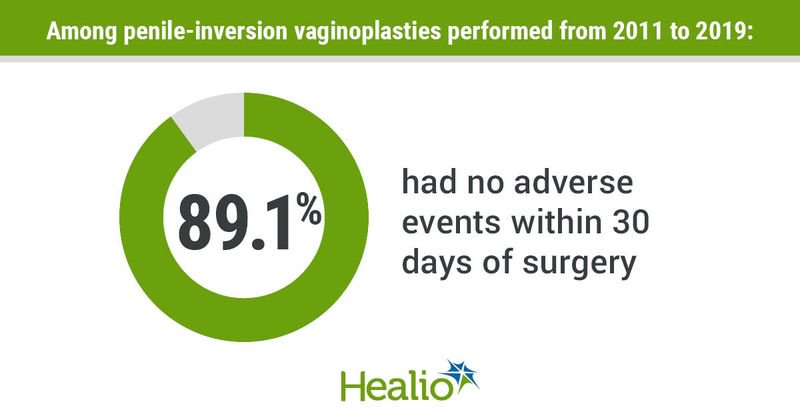Adverse events ‘rare’ in month after gender-affirming vaginoplasty
Click Here to Manage Email Alerts
Within 30 days of gender-affirming vaginoplasty, there were no deaths and few severe complications, according to the findings of a retrospective cohort study.
“Many transgender women undergo vaginoplasty surgery as part of their transition, and this gender-affirming procedure has increasingly been performed in the United States to help treat gender dysphoria in patients seeking surgery,” Kavita Mishra, MD, a clinical assistant professor of OB/GYN at the Stanford Pelvic Health Center in Redwood City, California, and Cecile A. Ferrando, MD, MPH, director of Cleveland Clinic’s transgender surgery and medicine program, wrote in the American Journal of Obstetrics & Gynecology.

“The most common gender-affirming vaginoplasty procedure is the penile-inversion vaginoplasty, and many modifications of this procedure exist,” they wrote. “Currently, multiple specialties perform these surgeries, including urology, gynecology and plastic and reconstructive surgery. Standards of care for the procedure are lacking.”
Mishra and Ferrando reviewed data available from 2011 to 2019 recorded in the American College of Surgeons National Surgical Quality Improvement Program (NSQIP) database. The NSQIP collects data on pre-, intra- and postoperative factors from more than 600 hospitals.
The researchers identified 488 penile-inversion vaginoplasty cases with codes for gender identity disorders and male-to-female vaginoplasty. For each case, they made note of clinical and demographic data, as well as stratified adverse events by Clavien-Dindo grades 0 through 5, where 0 corresponds with no adverse event and 5 corresponds with adverse event resulting in death.
Cohort characterization
Most patients were white (71.1%), non-Hispanic (81.5%), received surgery after 2017 (79.5%) and had their surgeries performed by plastic surgeons (87.9%).
The majority of cases (n = 434; 89.1%) did not have adverse events and were classified as Clavien-Dindo grade 0. There were two (0.4%) grade 1 cases, 24 (4.9%) grade 2 cases, 23 (4.7%) grade 3 cases and four (0.8%) grade 4 cases.
Within 30 days of surgery, there were no recorded deaths — and thus no grade 5 cases — cases of septic shock or renal failure, strokes, cardiac arrests, reintubations or failures to be weaned off ventilation, according to the study.
There were 34 cases of wound dehiscence, two cases of fistula, one case of rectal injury, six colectomies, one case of enterorrhaphy for perforation and no colostomies. Additionally, 23 patients returned to the operating room and 21 patients were readmitted.
Risks for adverse outcomes
Multivariate analyses revealed that cases classified as Clavien-Dindo grades 3 or 4 — which included surgical interventions and life-threatening adverse event requiring ICU treatment — were associated with higher BMI (P = .01), higher American Society of Anesthesiologists physical status class (P = .05) and lower preoperative hematocrit (P = .015).
Further, postoperative transfusion and steroid use were linked (P = .002). Hispanic ethnicity (P = .03), earlier year of surgery (P = .008) and diabetes (P = .006) were each associated with wound dehiscence, superficial surgical infection and deep surgical infection collectively.
Readmission was associated with higher BMI (P = .005), diabetes (P = .006) and hypertension (P = .01), and reoperation was associated with preoperative hematocrit (P = .006).
Sepsis and deep venous thrombosis/pulmonary embolism were not associated with any clinical or demographic characteristics.
“In transgender women undergoing vaginoplasty for gender affirmation, severe postoperative complications are rare, occurring in 1 in 20 patients,” Mishra and Ferrando wrote. “The majority of patients experience minor or no complications following surgery.”
“Further studies are required to evaluate specific preoperative and perioperative factors associated with major adverse events,” they wrote. “These factors should include patient-reported outcomes, perioperative use of gender-affirming hormone therapy and dosing, prior gender-affirming surgery, and concomitant surgery.”

